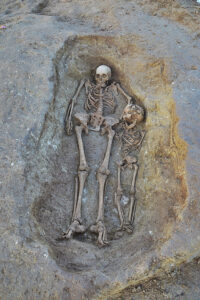 An excavation at the site of a future primary school in Marseille has revealed a cemetery from the Middle Ages that contains an unusual three double graves. The remains of an adult woman and a young child were found inside each of the graves, likely mothers and children. They died and were buried at the same time, and were laid to rest with tenderness and affection. In one of them, the child is holding the adult’s hand.
An excavation at the site of a future primary school in Marseille has revealed a cemetery from the Middle Ages that contains an unusual three double graves. The remains of an adult woman and a young child were found inside each of the graves, likely mothers and children. They died and were buried at the same time, and were laid to rest with tenderness and affection. In one of them, the child is holding the adult’s hand.
The cemetery was in use from the 7th to the 10th century A.D., but the double burials are from the earliest part of the range. The deceased were interred in shrouds and wore modest copper, bronze and iron jewelry typical of the Merovingian era. That dates the burials to the 7th or 8th century.
Archaeologists discovered almost 95 burials in the cemetery, many of them children. For the most part they were interred on their backs in simple graves. Some of the graves are tile burials in which the deceased was laid to rest on a bed of flat roof riles. A few of the graves are formed and lined by slabs of local stone. Neither the tile nor the cist burials have surviving roofs, but fragments found in the graves suggest some of them may have originally had covers. Wood fragments discovered in the some of the burials indicate the presence of wood planking.
The tombs were repeatedly reopened over the years, not by looters, but to make room for new bodies. After a decent interval to allow for the decomposition of soft tissues, a grave was opened and a newly-dead occupant added, often on top of the original occupant. The graves were likely visible on the surface in order for people to make these additions easily.
The site was occupied long before the Merovingian era. The excavation revealed a dozen or so pits and postholes dating to around 1400-1300 B.C., evidence of a Bronze Age occupation. One of the pits contained the remains of a child. One of the larger postholes contained a ceramic vessel that may have been used as cinerary urn for cremated remains. A large pit originally dug to extract clay for ceramics was later utilized as a temporary habitat. A plethora of stake holes point to it having been used as shelter by multiple people. Those were temporary structures, but a mudbrick wall points to the site having been used to erect more permanent dwellings later on in the Bronze Age.